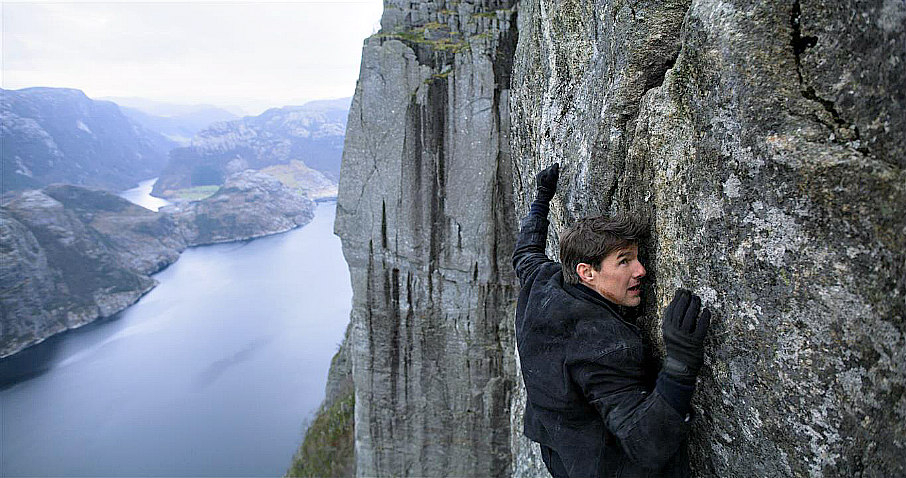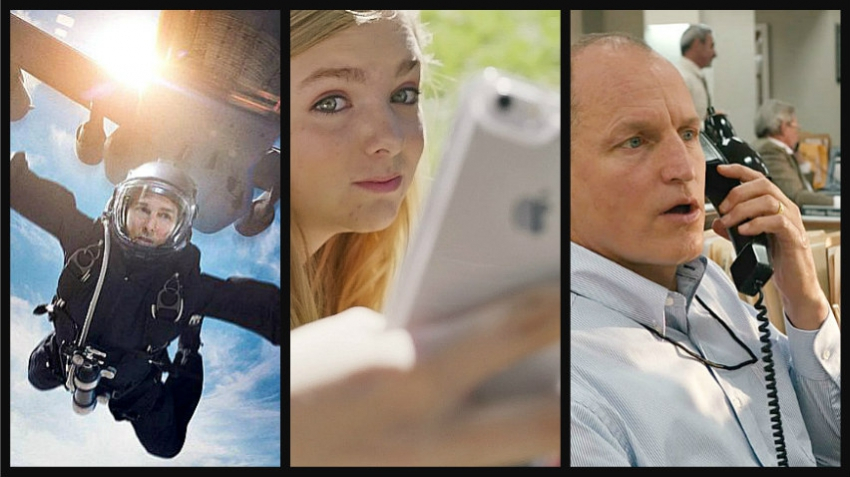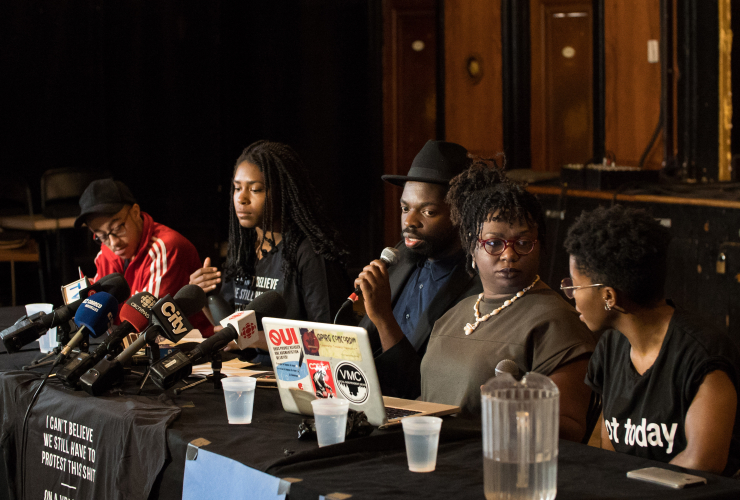With heat waves across Canada you might want an excuse to retreat into an air conditioned movie theatre. You’re in luck, because there are good films out.
Some of this week’s offerings are:
Mission Impossible Fallout: 3 ½ stars
Eighth Grade: 5
Shock and Awe: 3
Blindspotting: 4
The Third Murder: 4
Angels Wear White: 3 ½
Ryuichi Sakamoto Coda: 3 ½
Teen Titans Go! To the Movies: 2
MISSION IMPOSSIBLE FALLOUT: What’s impossible is that Tom Cruise has now been at this for 22 years. This is the sixth in the series and he’s not slowing down one bit. His stunts are bigger and wilder than ever. He dangles from ropes twice, once off a cliff, once climbing up to a helicopter in mid-flight. He also pilots that craft, runs atop buildings in London, jumps out of a plane through a storm and drops onto the Grand Palais in Paris and in one the most thrilling sequences rides a motorcycle against the traffic speeding around the Arc de Triomphe. In most of these scenes he’s being chased because, well, he’s trying to save the world and somebody else is trying to destroy a big chunk of it. One-third of the earth’s population is in immediate danger in this one.

Good luck getting the story straight, though. It’s convoluted, ever-shifting and powered by a villain we don’t see. He’s only spoken about in the dossier that opens the movie. He’s part of a shady organization called The Syndicate, which was introduced in the last film (Rogue Nation) and is intent on toppling the world order. It’s got three nuclear bombs and demands the return of one of its leaders who was captured in that last film. That carry-over of plot should engender continuity but writer-director Christopher McQuarrie seems to enjoy twists, mystery and deception more. Remember he wrote The Usual Suspects.

Ethan Hunt (Cruise) bungles his first attempt (for altruistic reasons) to get those nukes, brings his superiors (Angela Bassett, Alex Baldwin) to a boil and is encumbered with a shady sidekick he doesn’t want (Henry Cavill, a former Superman). His team (Simon Pegg, Ving Rhames, but not Jeremy Renner) are with him and three women interact significantly, a British agent introduced in the last film (Rebecca Ferguson), a slinky flirt named White Widow (suspicious for sure, and played by Vanessa Kirby) and much later Hunt’s wife (Michelle Monaghan) who disappeared a few films back. Ethan gets a chance to live out some personal dramas before the next action sequence comes along. You don’t have long to wait. They keep coming and are pretty well the chief reason for seeing this vigorous and often exciting bit of summer entertainment. 3 ½ out of 5
EIGHTH GRADE: Movies about teens come around quite often but few of them are as real, resonant and up to date as this one. There’s no bullying here, no fighting with parents, no snooty mean girls, no any of the usual. This is a true to life picture of one girl’s growing up depicted in small incidents. Anybody can connect because most everybody goes through a version of the same. Figuring out how you rate at school, for instance, in this case middle school, which we know as junior high. When the principal announces what he calls “the superlatives,” Kayla learns she’s been voted “the quietest.” At the pool she’s shy about her body. Her face is marked with acne. A normal kid, quietly dealing with her anxieties.

At home she speaks advice into her YouTube channel on subjects like Being Yourself (“Ignore them”), Putting Yourself Out There (“Go to places you don’t usually go”) and Confidence (“Make yourself confident.”) Naturally, these are exactly the challenges she has to face herself. We see her muddle through in the cafeteria, at a party, at dinner with dad trying to talk to her and in a car with a guy trying to get her to take her shirt off. Elsie Fisher does a remarkable job playing her. She’s so natural she doesn’t seem to be acting. The script, the ambience and the general understanding of her world is from Bo Burnham, the director who also started on YouTube and then in stand-up comedy. He’s made a smart, sometimes funny and always evocative film. 5 out of 5
SHOCK AND AWE: I for one am happy that there are still people out there making films as strong and radical as this. Documentaries do it all the time; this one is a drama. Evaluated as a movie it doesn’t rate too high because it plays a bit like an op-ed piece. But as analysis of how people can be fooled with a lie, it’s tops, and immensely relevant today.

The time is 15 years ago. The George W. Bush administration was looking for a response to the terrorist attacks that toppled the World Trade Centres in New York. Somebody came up with the idea of attacking Iraq. (Apparently a long-held desire). But on what pretext? Sadaam Hussein who hated Osama Bin Laden wasn’t involved in 9-11. Weapons of Mass Destruction, said George Bush. He must be stopped from using them. The evidence was fake, but papers like The New York Times and Washington Post printed what the White House told them and war went ahead. All that is known. This film is about the reporters who didn’t buy the official line. They worked for a consortium of 31 Knight-Ridder newspapers. Rob Reiner is the bureau chief (he also directed) and James Marsden, Woody Harrelson and Tommy Lee Jones, as reporters, present and past, do the digging. They work their contacts, cultivate leads, get leaks and detail a massive deception going on. Some of their papers, it’s not clear how many, refused to run those stories. The national mood was with Fox News, Sean Hannity, Rumsfeld, Cheney and Bush, all seen in actuality from the time and you hear some surprising names in the go-to-war vote. As drama it’s unsubtle and obvious. As a piece of protest journalism, it packs a punch. 3 out of 5
BLINDSPOTTING: The title is explained along the way: it means looking so intently at something that you miss seeing something just as important nearby. In this film, set in Oakland, Calif., race and class compete for attention. The hood is alive with black culture but gentrification is chipping away at it. Family pictures go out with the trash from a house to be demolished. A 140-year-old oak tree has been cut down. “Kill a hipster. Save the hood,” reads a sign.

In that community, finely detailed but changing fast, we spend time with two long time friends (that’s them in an Uber driver’s car) played by real-life friends who also wrote the film. Daveed Diggs, an award-winner for Hamilton, is black; his pal, Rafael Casal, is white but in a stark flip from what usually happens in films like this, the white guy is the boisterous impetuous one. Daveed is trying to be cool, staying out of trouble as the last three days of his probation creep to a close. We find out much later why he was in jail. Right now both are working for a moving company; they love to spout rap poetry together and Casal has an annoying habit of acting loose with a gun he carries. There’s enough there already to portend trouble but there’s more. Daveed sees a white cop shoot a black man, can’t react because he has to get home to comply with his curfew and is beleaguered by doubts about what to do. The story takes an all-to-easy next step but the film overall has a powerful, entertaining even, take on urban anger, race relations and friendship. 4 out of 5
THE THIRD MURDER: Ready for a good story told straight forward without tricks and gimmicks? This one from Japan fits that exactly. It’s mesmerizing to boot, wonderfully acted and crisply written. As an added bonus you get a clear view of court procedures in Japan. There’s a great deal of pre-trail conferencing for instance as both prosecution and defense reveal what they’ll be arguing. In this story that’s a bit tricky because the case that looks so overt is anything but. The accused has confessed to murdering his boss, withdrawn it and continues to change his story.

His lawyer confronts him, offers to deter a potential death sentence but gets only resistance. Years earlier the suspect avoided death on another murder conviction because the judge cited “extenuating circumstances.” “Back then, we believed social conditions generate crime,” the retired judge says now. But “circumstances” are discovered this time too, through the testimony of the victim’s daughter and the attempt by the suspect to blame the dead man’s widow. It gets very tangled but with lean writing and sharp directing by Hirokazu Kore-eda the film is also tense and engrossing. The main actors, Isao Hashizume as the lawyer and Kôji Yakusho as the suspect, helped write the script. Both are prominent actors in Japan; the latter best known to us for the hit film Shall We Dance. 4 out of 5
ANGELS WEAR WHITE: The mood is calm and clinical but there’s so much that’s lurid underneath, I’m surprised China let this one out of the country. Vivian Qu’s second film slashes away at official visions of society and finds corruption, sex-abuse and patriarchal misuse of power underneath. It’s only one story, but filled out in so many ways, it seems to be intended as widespread condemnation. With little noise and no histrionics, it calls on you to think hard to find that extra meaning.

On the surface it’s a brightly filmed story at a seaside resort where a giant statue of Marilyn Monroe stands on the beach, tourists film it from below and a young undocumented worker is inspired to dream. She’s a cleaner at a hotel, subs for a carousing desk clerk one night and checks in a man with two underage girls. Later she shoots a cell phone picture from the security monitor as the guy forces his way into the girls’ room. She can’t tell anyone though because she has no papers. The police do a weak investigation (for reasons we find out later) and only a diligent woman lawyer sticks with it. Various people want money; parents betray their children, important people are protected, and hymens are reconstructed. It’s a grim indictment all around but briskly told and ends with a starkly ironic image and lots to think about. 3 ½ out of 5
RYUICHI SAKAMOTO: CODA: Here’s a sparkling introduction to a composer you may not know but have surely heard. He won an Oscar for scoring The Last Emperor. More recently he created the music for The Revenant and among his many other titles there’s Merry Christmas Mr. Lawrence, in which he also acted and Davie Bowie gave him a kiss. Excerpts from all these and more are clipped into the film as he talks about them, about his creative process and two aspects of his personal life. He’s an ecological activist, both speaking and demonstration against nuclear power and global warming. “If I feel strongly about something, I can’t look the other way,” he says.
On a sad note, he learns he has throat cancer, originally finds it hard to believe (“It still feels like a joke”) and then explains the difficulties it has brought on him. Still it’s a dignified and amiable image we get of him playing and talking at the piano or working in his studio. What he calls “perpetual sound” fascinates him. Or water, the purest sound he’s ever heard. The film is a visit not a full biography. It fails to mention that he lives as much in New York as Japan or much of his early history. As a member of one band long ago he’s credited with pioneer work in both electro-pop and hip hop. Very pleasant to meet him. 3 ½ out of 5
TEEN TITANS GO! TO THE MOVIES: They’ve been around in various configurations and media since 1964 (comics, TV, video, and now Netflix) but I haven’t been familiar with them. I’m told though by two regular viewers that this movie is exactly like the series being shown these days. So fans can be assured; they’ll get what they expect. For the rest of us, it’s something of a letdown. Animated films are so good these days, imaginative, glistening, clever. This one is pretty standard. More problematic: the creators looking for cheeky humor try way too hard to be hip.

The five teen superheroes, Robin, Starfire, Raven, Beast Boy and Cyborg protect Jump City from the usual type of comics villains. They’re like teens everywhere; they argue, they bicker, they’re endearing. But when the villain of the day, Slade, voiced by Will Arnett, says they’re a joke, not real heroes, Robin gets an idea. Off they go to Hollywood looking for a movie deal, like real super heroes have. We get a lot of movie references and in jokes. There are jabs at Marvel Comics and their films (this one is from the rival DC comics). There are several funny trailers for imaginary upcoming movies and two cameos by Stan Lee. The fanboys get that; do the kids? The teens try eliminating the other super heroes and when that fails search for an arch nemesis. The animation is simple and TV quality and the wit is less than sparkling. 2 out of 5




Comments